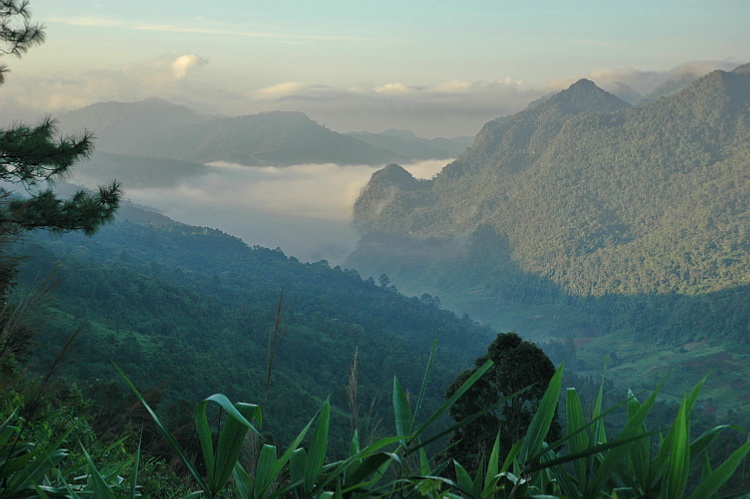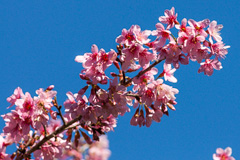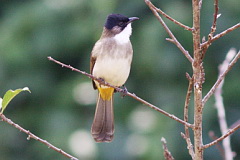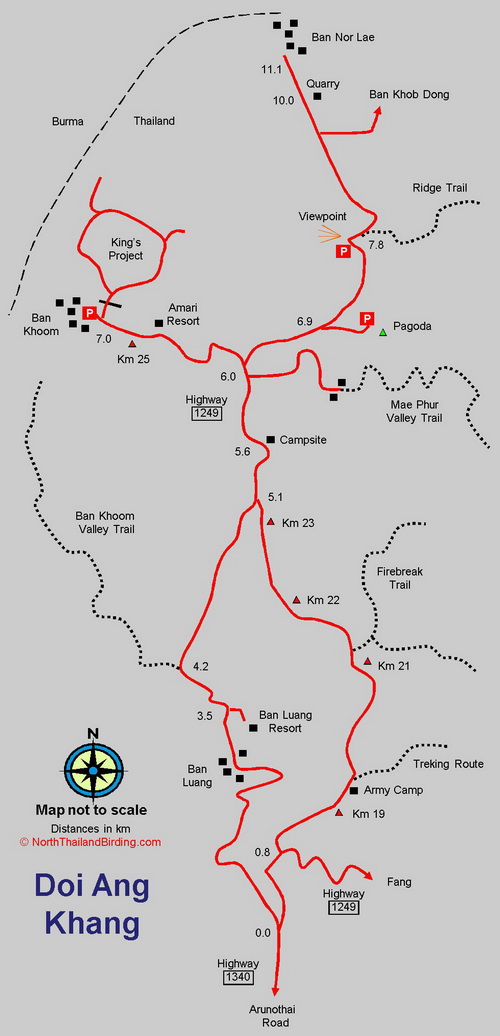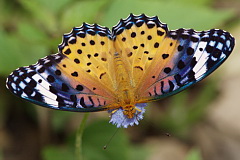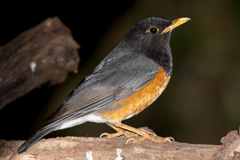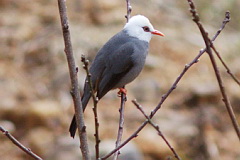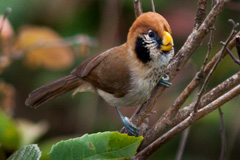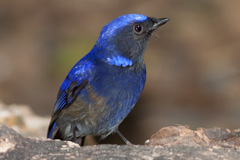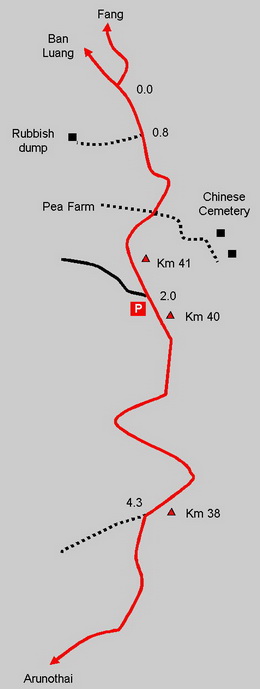Overview
Doi Ang Khang, in the northwestern corner of Thailand, hosts a number of mountain species shared with the adjacent mountains of Doi Pha Hom Pok and Doi Lang. Although the area forms part of the Doi Pha Hom Pok National Park, there appears to be no policing or protection enforced. Some good patches of drier highland pine-oak forest remain, as well as much scrub, which combine to hold a diversity of dry season visitors. The area is especially notable for a large and confusing array of wintering Phylloscopus warblers. Cold winters in China sometimes result in rare and interesting thrushes turning up. Information on this page verified/accurate as of 19 Jan 2023.
View along the Arunothai valley road
Access
Doi Ang Khang can be accessed from the south, via Chiang Mai and Chiang Dao, or the north via Fang. From Chiang Mai, head north on Highway 107 to about seven kilometres past Chiang Dao and turn left onto Highway 1178, signposted to Wiang Haeng. Zero the trip meter at this junction. Continue along Highway 1178 for 31.2 kilometres to the first army checkpoint immediately after which turn right onto Highway 1340, signposted Doi Ang Khang. The next five kilometres to the village of Arunothai can be good for Rufous-winged Buzzard and, in winter, Eastern Buzzard. At 37.6 kilometres at the T-junction in Arunothai turn right. Another army checkpoint is passed at 51.7 kilometres, and an excellent viewpoint is found at 59.0 kilometres. From here the road winds higher and higher, passing into better habitat, as far as 73.5 kilometres where the road forks just before the village of Ban Luang. Bearing right at the fork leads to the eastern side of the Ang Khang loop road and the steep downward route to Fang. Keeping left at the fork passes through the Hmong village of Ban Luang, which although interesting culturally could also be described as squalid.
If arriving from the north, head southward from Fang on Highway 107, for about 13 kilometres, to turn right at the Km 137 marker, onto Highway 1249, signposted to Doi Ang Khang. From this junction it's about 25 kilometres to Doi Ang Khang. Note that the latter sections of this road are extremely steep, with small-engined vehicles, if overloaded, frequently overheating.
|
Accommodation and FacilitiesAs most of Doi Ang Khang is at 1,400 - 1,800 metres, the cool, frequently freezing, dry season weather has turned the area into a popular weekend retreat. Too much so, with the area being totally overrun with local tourists during busy weekends such as New Year, when best avoided. In the past, this resulted in a fair number of guesthouses and bungalows springing-up. However, in 2019 all accommodation, even the national park campsite was closed down, the exact reasons for which remain unclear. |
It is still possible to camp at the sole remaining military campsite, but the best option now is to stay in Fang and drive up early morning, allowing an hour for the drive. Small shops and restaurant facilities are concentrated around the parking area of Ban Khoom, which are open early and late.
BirdingA fair number of wide trails and firebreaks, as well as many roadside birding possibilities, make Ang Khang fairly easy to cover and well worth two or three days. Some of the specialities include Crested Finchbill, Brown-breasted Bulbul, Spot-breasted Parrotbill, Mrs. Hume's Pheasant, Black-headed Greenfinch, Black-breasted Thrush and White-browed Laughingthrush. However, several of these can be tricky to find so several days are worthwhile for those with time. The whole Ang Khang area is rather limited in extent, and most of the species move around and can be found anywhere. For those with limited time, the best areas to concentrate on are the Km 21 and Firebreak Trail, the Mae Phur Valley Trail and the Arunothai road. Additionally if thrushes are in evidence, the King's Project. Early morning low cloud and fog can be problematic. |
|
King's ProjectAs the grounds of this large project are primarily cultivated gardens and fruit orchards, they are heavily visited by local tourists and of no real interest to birders. However, most winters, photographers set up baiting stations - usually in the vicinity of the restaurant - that attract an interesting selection of thrushes, niltavas and the occasional rarity. Black-breasted Thrush is the most regular, as well as Rufous-bellied Niltava, Hill Blue Flycatcher and Large Niltava. Rare thrushes regularly turn up with colder weather. Km 21 and Firebreak Trail Being slightly wetter, the eastern side of the mountain holds what little remains of evergreen rainforest at Doi Ang Khang. The start of the trail is actually at Km 21.3 with a small parking area and a wooden sign for trekking. A short flight of steps leads up to the left to a shrine, but can be ignored. Following the main track for about 50 metres, at which point a small track branches off right, passing through a couple of hundred metres of darker denser forest before emerging onto a hillside where it follows a wide cow track for at least a kilometre through open scrub and wooded slopes. The denser forest can hold Small Niltava, Scarlet-faced Liocichla, Martens's Warbler, Slaty-backed Flycatcher and Rufous-throated Partridge. The more open areas can be good for Red-eyed Scimitar Babbler, Grey Treepie, Spot-throated Babbler, and occasionally Spot-breasted Parrotbill. The open wooded canopy is good for Phylloscopus warblers with Claudia's Leaf Warbler and Pallas's Leaf Warbler possible. The undergrowth has Buff-throated Warbler. |
Not turning right, and keeping to the main track, leads to a rocky trail through scrubby forest for a few hundred metres to emerge on an open ridge known as the Firebreak Trail, which is level for a few hundred metres but then drops steeply. This open trail provides excellent views over the valleys on both sides where species such as White-browed Laughingthrush, Great Barbet, Spot-throated Babbler, Spot-breasted Parrotbill, Aberrant Bush Warbler and sometimes Spot-winged Grosbeak can be found. Cook's Swift is frequent in large numbers over the ridge and often joined by Asian House Martin and, infrequently, Himalayan Swiftlet.
|
Mae Phur Valley Trail Just after the Ang Khang campsite, and immediately before the turn to Lor Lae and the Burma border, a short concreted road turns right down to a forest station and a few workers houses. Park just before the houses and follow the wide dirt track along the Mae Phur Valley. This trail follows a narrow stream, through a mixture of wetter forest and bamboo, for about 1.5 kilometres where it ends at a stream crossing. Forest here is often rather quiet, but a number of interesting species can be found with determination and luck, including, Lesser Shortwing, Slaty-blue Flycatcher, White's Thrush and Pale-billed Parrotbill. In the past, Rusty-naped Pitta has been found. A night walk should produce several vocal nightbirds, although accessibility to forest on the steep banks means seeing them is difficult. Possible species include Mountain Scops Owl, Hodgson's Frogmouth, Himalayan Wood Owl, Grey Nightjar and Collared Scops Owl. Ban Khoom Valley Trail Although this valley is heavily farmed, scrub and fields here are worth a look, time-permitting. The start of the trail is most easily found from the Ban Luang end, starting at an obvious wide track, 700 metres after the Ban Luang Resort entrance. The trail initially descends into the valley bottom, then traces the other side of the valley all the way to Ban Khoom. Some of the more interesting species seen along here include Russet Bush Warbler, Buff-throated Warbler, Yellow-legged Buttonquail, Common Rosefinch, Red-eyed Scimitar Babbler and Daurian Redstart. Ang Khang Pagoda A small pagoda, which is signposted, can be found by turning off 900 metres along the Nor Lae road. Both the short entrance road and the trees around the pagoda can be very good for feeding flocks, especially when the trees are fruiting or flowering. Look for Phylloscopus warblers, flycatchers and bulbuls. This area is worth checking early morning if the other side of the mountain is overcast and fog bound. Viewpoint and Ridge Trail Continuing a little farther along the Nor Lae road a large parking area and a viewpoint are reached. The immediate area can be rather busy and disturbed at weekends, but a trail on the right hand side of the road can be followed for at least a couple of kilometres. The first couple of hundred metres of this trail are fairly steep uphill, but once on the ridge this wide firebreak is fairly level. Habitat is open scrub with some taller trees farther along. The area holds Chestnut-bellied Rock Thrush, Spot-breasted Parrotbill, White-browed Laughingthrush and Buff-throated Warbler. The open views can be good for raptors. Ban Nor Lae Road The remainder of the road to Ban Nor Lae and the Burma border contains a mixture of cutover forest, scrub and on approach to Ban Nor Lae, mostly fields. Simply stopping and birding anywhere along the road can produce wandering flocks of passerines and scrub should be investigated for any skulking species such as White-bellied Redstart. Crested Finchbill and Brown-breasted Bulbul can sometimes be found in the more open areas toward Ban Lor Lae. Black-headed Greenfinch is present in larger stands of pines some winters. The paved road, branching off toward Ban Khob Dong passes good forest edge for the first 500-600 metres with Silver-eared Mesia regular. |
Ban Luang to Chinese Cemetery and Pea Farm If staying at Ban Luang Resort the garden and surrounding slopes can be productive. A small stream runs through the garden which sometimes has White-capped Redstart, Crested Finchbill, White-headed Bulbul, Little Bunting and Brown-breasted Bulbul. The level stretch of road between Ban Luang and the Chinese Cemetery is primarily low scrub, but often very productive early morning when the sun first hits the slopes. Mountain Bamboo Partridge is common here but extremely shy and rarely seen. Species to be looked for here include Red-eyed Scimitar Babbler, White-browed Scimitar Babbler, White-browed Laughingthrush, Long-tailed Minivet, Silver-eared Mesia, Russet Bush Warbler, Siberian Rubythroat, Eastern Buzzard, Grey-backed Shrike, Grey-crowned Warbler, Spot-throated Babbler and Daurian Redstart. The thick scrub around the Chinese Cemetery and the Pea Farm can be investigated for Little Bunting, Chestnut Bunting, White-bellied Redstart, Buff-throated Warbler, Brown-breasted Bulbul, Siberian Stonechat and White-browed Laughingthrush. Large pines in the area can attract Black-headed Greenfinch. Note that the name Pea Farm is a misnomer as the area has, in 2012, been replanted with fruit trees, which may well make the area far less productive within a couple of years. Arunothai Road Starting from the Chinese Cemetery, the Arunothai road starts to drop through 10-12 kilometres of open pine-oak forest. Birding can be done anywhere along the road, which is not usually busy with traffic, except at weekends when numbers of tourists descend on the mountain. Mrs. Hume's Pheasant can occur anywhere at Doi Ang Khang but is more often seen here, though it's more a case of luck than anything. A few wider, often steep, tracks branch off the road, usually leading to farms in the valleys, but can be used to get away from traffic. The drier habitat of this slope is better for a number of species such as Pallas's Leaf Warbler, Sapphire Flycatcher, Pale Blue Flycatcher, Collared Owlet, Grey-headed Parrotbill and Spot-breasted Parrotbill. Larger pines in the region of Km 38 occasionally attract Giant Nuthatch. Note that the Kilometre markers were renumbered in 2011, so old trip reports refer to markers seven kilometres lower than now. |
Checklist
Checklist of species.
Gallery
Additional images from Doi Ang Khang available in the Thailand Travel gallery.
Sunrise and Sunset
Detailed sunrise and sunset times.

